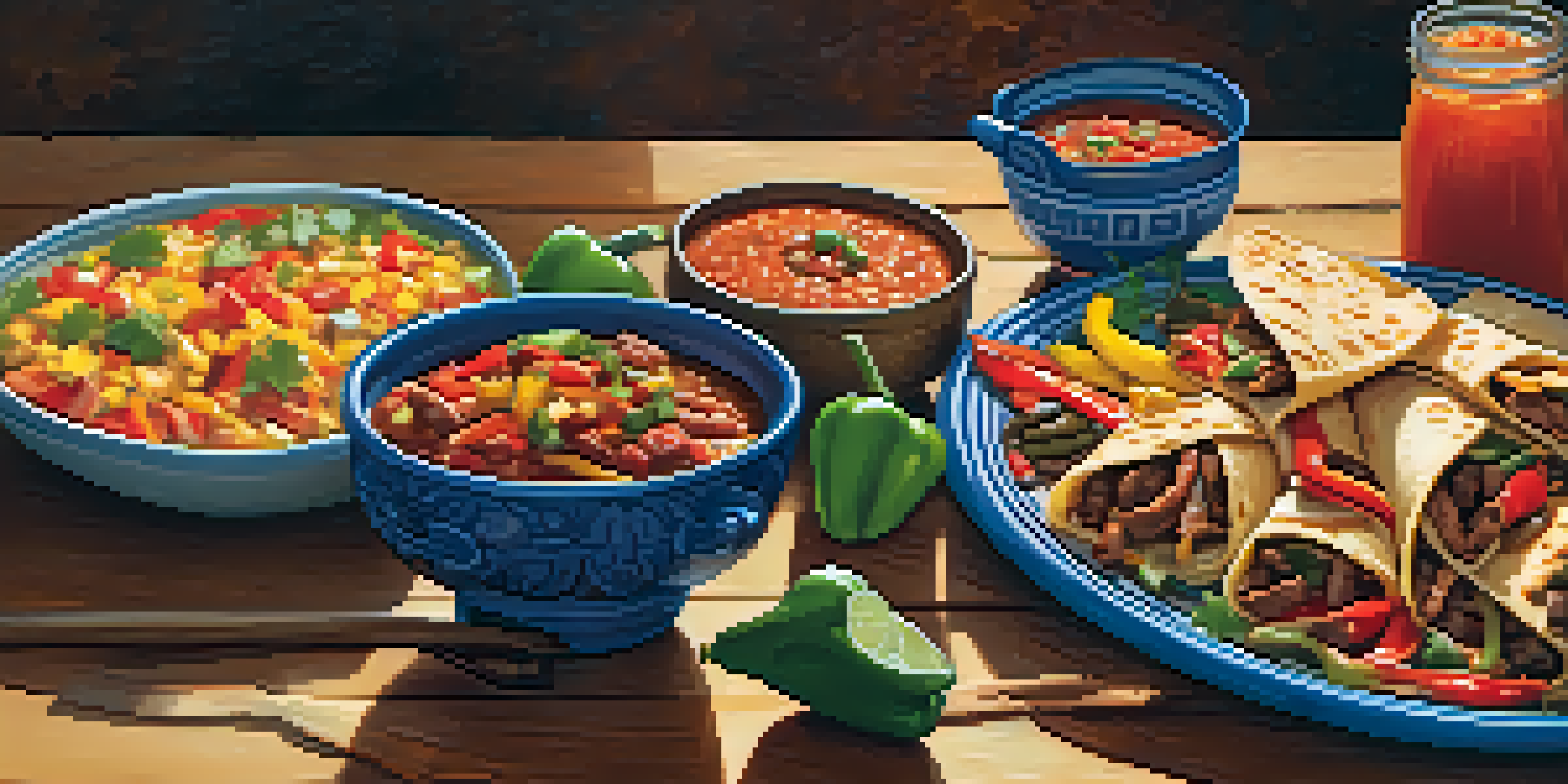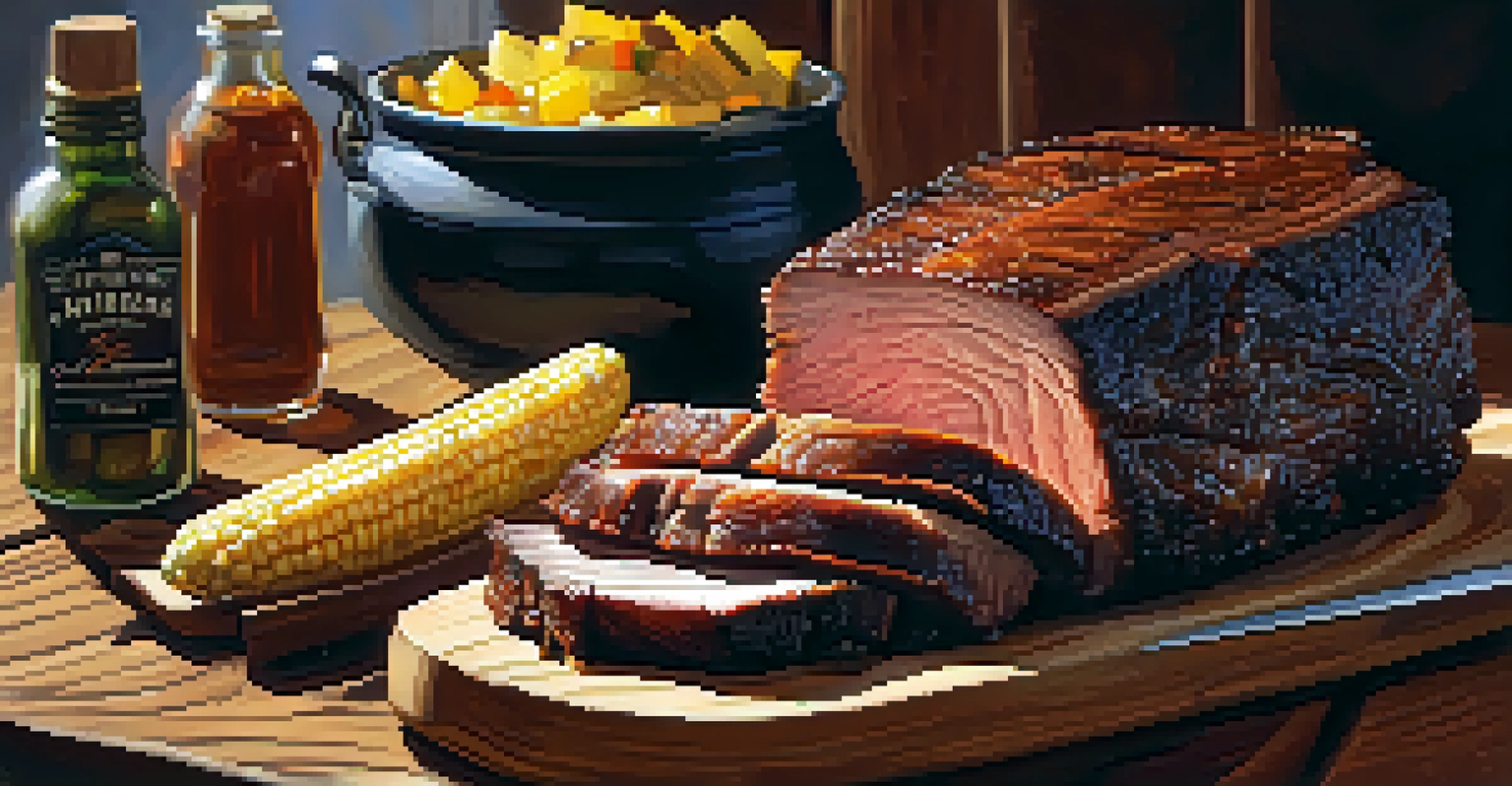Texas' Influence on American Cuisine: A Culinary Overview

The Roots of Texas Cuisine: A Cultural Melting Pot
Texas cuisine is a vibrant tapestry woven from various cultural influences. The state's history is marked by Indigenous, Spanish, Mexican, and German settlers who each brought their culinary traditions. This melting pot has created a unique food culture that stands out in American cuisine.
Food is our common ground, a universal experience.
For instance, the fusion of Mexican and Texan flavors birthed the beloved Tex-Mex cuisine, featuring dishes like enchiladas and nachos. This blend not only showcases the state's diversity but also highlights how food can bring different cultures together. Texas has truly become a culinary crossroads, where flavors collide and evolve.
Moreover, the state's vast geography lends itself to an array of local ingredients, from beef and barbecue to fresh produce. Each region has its specialties, ensuring that Texas cuisine remains dynamic and ever-changing, reflecting the state's rich cultural heritage.
Barbecue: The Heart and Soul of Texas Cooking
When you think of Texas cuisine, barbecue likely comes to mind. This cooking style, particularly from Central Texas, is renowned for its focus on smoked meats, especially brisket. The slow-cooking method, often using post-oak wood, infuses the meat with a deep, smoky flavor that has become iconic.

Barbecue joints across the state have cultivated a passionate following, with many people traveling for miles to indulge in their favorite spots. Events like barbecue festivals celebrate this culinary art, showcasing the regional differences and techniques that make Texas barbecue so special. It's more than just a meal; it's a communal experience.
Texas Cuisine: A Cultural Blend
Texas cuisine is a rich tapestry of cultural influences, blending Indigenous, Spanish, Mexican, and German traditions that create a unique culinary identity.
In recent years, Texas barbecue has gained national acclaim, influencing restaurants and chefs across the country. The widespread popularity of Texas-style barbecue has not only shaped local traditions but has also cemented its place in the broader narrative of American cuisine.
Tex-Mex: A Flavorful Fusion of Cultures
Tex-Mex cuisine is a beloved staple that exemplifies the cultural fusion of Texas. With roots in Mexican cuisine, Tex-Mex incorporates local ingredients and cooking styles to create dishes that are uniquely Texan. From sizzling fajitas to cheesy quesadillas, these flavors have become household favorites.
Cooking is like love. It should be entered into with abandon or not at all.
The combination of spices, textures, and presentation makes Tex-Mex a vibrant culinary experience. The use of ingredients like cheddar cheese, ground beef, and flour tortillas distinguishes it from traditional Mexican food, creating a flavorful twist that appeals to a wide audience. It’s a perfect example of how food evolves as cultures blend.
Tex-Mex has also played a significant role in American food culture, influencing menus across the nation. As this cuisine spreads, it showcases the rich history and diversity of Texas, highlighting how regional dishes can transcend borders and become beloved far beyond their origins.
Southern Influences: Comfort Food at Its Best
Texas cuisine is deeply intertwined with Southern cooking traditions, bringing comfort food to the forefront. Dishes like chicken-fried steak, cornbread, and okra are just a few examples of how Southern influences have shaped the culinary landscape of the state. These hearty meals not only nourish but also tell stories of family and tradition.
The emphasis on communal dining in Texas reflects the Southern hospitality that welcomes everyone to the table. Meals are often shared among friends and family, creating a sense of belonging and warmth. This connection to food as a gathering point adds a rich layer to the dining experience.
Barbecue: Texas' Culinary Icon
Central Texas barbecue, especially its smoked brisket, has become a symbol of the state's food culture, celebrated for its communal experience and deep flavors.
Additionally, the prominence of soul food in Texas showcases the African American influence on Southern cooking. Ingredients and techniques have been passed down through generations, ensuring that these traditions remain alive and continue to evolve in the heart of Texas.
Seafood: A Taste of the Gulf Coast
Texas' long coastline along the Gulf of Mexico offers a bounty of fresh seafood that has become integral to its culinary identity. Dishes like shrimp and grits, fried catfish, and spicy gumbo showcase the state's connection to the sea. Coastal cities, such as Galveston and Port Aransas, are known for their vibrant seafood markets and restaurants.
The influence of coastal cuisine extends beyond just seafood; it incorporates spices and cooking techniques from various cultures. For example, the use of Cajun and Creole spices reflects the rich heritage of the Gulf region, adding a distinctive flair to Texas dishes. This cross-pollination of flavors makes Texas seafood truly unique.
Seasonal festivals celebrating seafood, like the Texas Crab Festival, highlight the importance of these culinary traditions. These events not only promote local seafood but also create a sense of community, bringing people together to enjoy the flavors of the Gulf.
Texan Sweets: Indulging in Local Desserts
No culinary exploration of Texas would be complete without mentioning its delicious desserts. Classic treats like pecan pie and peach cobbler showcase the state's agricultural bounty, particularly its nuts and fruits. These desserts reflect the rich history of farming in Texas, where local ingredients shine.
Bakery culture in Texas is thriving, with local shops offering a variety of sweet indulgences. From traditional Mexican pastries like tres leches cake to Southern-inspired treats like buttermilk pie, there’s something for everyone’s sweet tooth. These desserts often carry personal stories and family recipes, adding a layer of nostalgia to each bite.
Innovation in Texas Dining
The future of Texas cuisine embraces innovation through farm-to-table practices and food trucks, blending traditional recipes with modern techniques and global flavors.
Moreover, food festivals often highlight these sweet specialties, allowing visitors to indulge in a range of flavors and textures. By celebrating local desserts, Texas not only preserves its culinary heritage but also invites others to appreciate the state's unique approach to sweets.
The Future of Texas Cuisine: Innovation Meets Tradition
As Texas continues to evolve, so too does its culinary landscape. Chefs and home cooks alike are experimenting with traditional recipes while incorporating modern techniques and global flavors. This innovative spirit reflects the dynamic nature of Texas, where new ideas are embraced while honoring the past.
Farm-to-table dining has gained traction in Texas, with many restaurants sourcing ingredients from local farms. This movement not only supports local economies but also encourages chefs to create dishes that highlight seasonal produce. The emphasis on freshness and sustainability is redefining what it means to enjoy Texas cuisine.

Additionally, the rise of food trucks and pop-up restaurants showcases the entrepreneurial spirit of Texas chefs. These mobile kitchens often experiment with bold flavors and unique combinations, making Texas cuisine more accessible and diverse. The future of Texas cuisine is bright, promising exciting new culinary adventures.